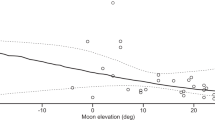Abstract
It has been proposed1–4 that a flying male moth finds its way to a ‘calling’ female or other small, distant source of wind-borne sex pheromone using two contrasting anemotactic manoeuvres: (1) upwind flight in response to the onset or increase of the pheromone stimulus, maintained as long as the stimulus continues, and (2) cross-wind flight with switching between left and right of the wind line (the so-called ‘track reversals’4 or ‘tack reversals’5 seen in casting or zig-zagging) which occurs only in response to the loss or decrease of the pheromone stimulus. A simpler system can now be proposed in the light of wind-tunnel experiments on male summerfruit tortrix moths (Adoxophyes orana) entering homogeneous pheromone clouds. The moths did not fly persistently upwind with continuous pheromone stimulation, and their programmed left–right track reversals occurred in response to pheromone onset, not loss, and continued after pheromone loss but with widening cross-wind excursions between reversals.
This is a preview of subscription content, access via your institution
Access options
Subscribe to this journal
Receive 51 print issues and online access
$199.00 per year
only $3.90 per issue
Buy this article
- Purchase on Springer Link
- Instant access to full article PDF
Prices may be subject to local taxes which are calculated during checkout
Similar content being viewed by others
References
Farkas, S. R. & Shorey, H. H. in Pheromones (ed. Birch, M. C.) 81–95 (North-Holland, Amsterdam, 1974).
Kennedy, J. S. & Marsh, D. Science 184, 999–1001 (1974).
Kennedy, J. S. in Chemical Control of Insect Behaviour: Theory and Application (eds Shorey, H. H. & McKelvey, J. J.) 67–91 (Wiley, New York, 1977).
Marsh, D., Kennedy, J. S. & Ludlow, A. R. Physiol. Ent. 3, 221–240 (1978).
Cardé, R. T. & Hagaman, T. E. Envir. Ent. 8, 475–484 (1979).
Farkas, R., Shorey, H. H. & Gaston, L. K. Ann. ent. Soc. Am. 67, 633–638 (1974).
Author information
Authors and Affiliations
Rights and permissions
About this article
Cite this article
Kennedy, J., Ludlow, A. & Sanders, C. Guidance system used in moth sex attraction. Nature 288, 475–477 (1980). https://doi.org/10.1038/288475a0
Received:
Accepted:
Issue Date:
DOI: https://doi.org/10.1038/288475a0
This article is cited by
-
10.1007/BF00186157
CrossRef Listing of Deleted DOIs (2011)
-
Physiology and antennal lobe projections of olfactory receptor neurons from sexually isomorphic sensilla on male Heliothis virescens
Journal of Comparative Physiology A (2007)
-
Analysis and Manipulation of the Structure of Odor Plumes from a Piezo-Electric Release System and Measurements of Upwind Flight of Male Almond Moths, Cadra cautella, to Pheromone Plumes
Journal of Chemical Ecology (2007)
-
Physiology and glomerular projections of olfactory receptor neurons on the antenna of female Heliothis virescens (Lepidoptera: Noctuidae) responsive to behaviorally relevant odors
Journal of Comparative Physiology A (2006)
-
Interactions of mechanical stimuli and sex pheromone information in antennal lobe neurons of a male moth, Spodoptera littoralis
Journal of Comparative Physiology A (2005)
Comments
By submitting a comment you agree to abide by our Terms and Community Guidelines. If you find something abusive or that does not comply with our terms or guidelines please flag it as inappropriate.



